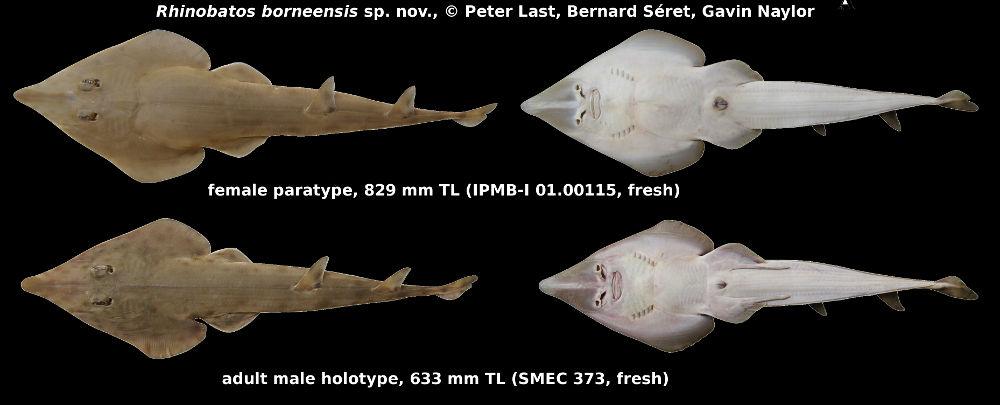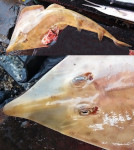Rhinobatos borneensis
Last, Séret & Naylor, 2016
Borneo Shovelnose Ray
Classification: Elasmobranchii Rhinopristiformes Rhinobatidae
Reference of the original description
A new species of guitarfish, Rhinobatos borneensis sp. nov. with a redefinition of the family-level classification in the order Rhinopristiformes (Chondrichthyes: Batoidea). Zootaxa, 4117(4), 451–475
A new species of guitarfish, Rhinobatos borneensis sp. nov. with a redefinition of the family-level classification in the order Rhinopristiformes (Chondrichthyes: Batoidea). Zootaxa, 4117(4), 451–475
Types
Rhinobatos borneensis
Holotype: SMEC: 373; Paratype: CSIRO: H 7086–01; CSIRO: H 7543–01; CSIRO: H 7544–01; IPMB: I 01.00115; IPMB: I 01.00117; SMEC: 374;
Rhinobatos borneensis
Holotype: SMEC: 373; Paratype: CSIRO: H 7086–01; CSIRO: H 7543–01; CSIRO: H 7544–01; IPMB: I 01.00115; IPMB: I 01.00117; SMEC: 374;
Description :
Citation: Rhinobatos borneensis Last, Séret & Naylor, 2016: In: Database of modern sharks, rays and chimaeras, www.shark-references.com, World Wide Web electronic publication, Version 04/2024
Please send your images of "Rhinobatos borneensis" to info@shark-references.com

Rhinobatos borneensis Last, Séret & Naylor, 2016; adult male holotype, 633 mm TL (SMEC 373) and female paratype, 829 mm TL (IPMB-I 01.00115); © Last, P.R. & Séret, B. & Naylor, G.J.P.

Rhinobatos borneensis Last, Séret & Naylor, 2016; adult male holotype, 633 mm TL (SMEC 373) and female paratype, 829 mm TL (IPMB-I 01.00115); © Last, P.R. & Séret, B. & Naylor, G.J.P.
Common names
 Borneo Shovelnose Ray
Borneo Shovelnose Ray
 Borneo Shovelnose Ray
Borneo Shovelnose Ray
Short Description
Original diagnosis after LAST, SÉRET & NAYLOR, 2016 [24200]: A species of the genus Rhinobatos distinguished by the following combination of characters in adults: wedge-shaped disc, width 29–31% TL, disc length 1.30–1.42 times width; snout length 2.5–3.3 times interspiracular distance, 3.8–5.6 times interorbital width; medium-sized orbit, 1.5–2.2 times spiracle length; weakly oblique nostrils, their length 1.5–1.7 times internarial distance; preoral length 7.4–8.1 times internarial distance; anterior nasal flaps penetrating slightly into internarial space but well separated at their insertion (not reaching level of inner corner of nostril); posterior nasal flaps broad; two spiracular folds, outermost fold distinctly taller than inner fold; ridges of rostral cartilage almost parallel, converging slightly anteriorly but not constricted medially; anterior cartilage sickle shaped, pointed or blunt posteriorly; distance between fifth gill slits 2.7–3.3 times in ventral head length; prebranchial sensory pore patch obvious, extending to just behind first gill slit; postscapular sensory canal obvious, with exposed lateral pores, grooved; thorn patches on supraorbit, scapular region, and dorsal midline rudimentary, not conspicuous; pelvic-fin inner margin subequal to its base in males, shorter in females; interdorsal distance 2.5–3.3 times first dorsal-fin base; dorsal caudal margin 1.9–2.3 times preventral margin; upper jaw with ca. 90 tooth rows; 176–180 post-synarcual centra; 50–53 nasal lamellae; dorsal fin usually with a large, often faint, central dusky blotches; dorsal disc of adults yellowish or brownish, often with diffuse pale yellowish blotches, without white spots; young with ocellate markings.
Original diagnosis after LAST, SÉRET & NAYLOR, 2016 [24200]: A species of the genus Rhinobatos distinguished by the following combination of characters in adults: wedge-shaped disc, width 29–31% TL, disc length 1.30–1.42 times width; snout length 2.5–3.3 times interspiracular distance, 3.8–5.6 times interorbital width; medium-sized orbit, 1.5–2.2 times spiracle length; weakly oblique nostrils, their length 1.5–1.7 times internarial distance; preoral length 7.4–8.1 times internarial distance; anterior nasal flaps penetrating slightly into internarial space but well separated at their insertion (not reaching level of inner corner of nostril); posterior nasal flaps broad; two spiracular folds, outermost fold distinctly taller than inner fold; ridges of rostral cartilage almost parallel, converging slightly anteriorly but not constricted medially; anterior cartilage sickle shaped, pointed or blunt posteriorly; distance between fifth gill slits 2.7–3.3 times in ventral head length; prebranchial sensory pore patch obvious, extending to just behind first gill slit; postscapular sensory canal obvious, with exposed lateral pores, grooved; thorn patches on supraorbit, scapular region, and dorsal midline rudimentary, not conspicuous; pelvic-fin inner margin subequal to its base in males, shorter in females; interdorsal distance 2.5–3.3 times first dorsal-fin base; dorsal caudal margin 1.9–2.3 times preventral margin; upper jaw with ca. 90 tooth rows; 176–180 post-synarcual centra; 50–53 nasal lamellae; dorsal fin usually with a large, often faint, central dusky blotches; dorsal disc of adults yellowish or brownish, often with diffuse pale yellowish blotches, without white spots; young with ocellate markings.
Size / Weight / Age
type series contains three adult males, 633–686 mm TL, and at least two larger adult females, 829–900 mm TL [24200]
type series contains three adult males, 633–686 mm TL, and at least two larger adult females, 829–900 mm TL [24200]
Habitat
demersal; marine
demersal; marine
Dentition
Teeth small, blunt, crowns rhomboidal with weak, pointed posterior cusps; teeth quincuncial, in ~90–91 rows in upper jaw; upper and lower jaw teeth similar in shape and size [24200]
Teeth small, blunt, crowns rhomboidal with weak, pointed posterior cusps; teeth quincuncial, in ~90–91 rows in upper jaw; upper and lower jaw teeth similar in shape and size [24200]
Remarks
shark-references Species-ID=14578;
shark-references Species-ID=14578;

















